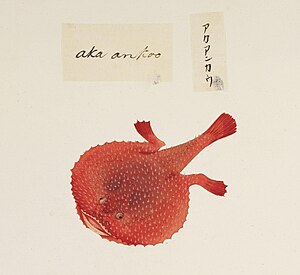
Written And Reviewed by:
Today, Our deep sea creature is the batfish or the deepsea batfish; it belongs to the common family of anglerfish(scientifically known as Ogcocephalidae), it has a creepy name I think, it’s specifically adapted to the benthic lifestyle. They are also called deep-sea batfishes, handfishes, and seabats. There are about 60 species of batfish
Where do they live?
They were spotted in tropical and subtropical oceans worldwide. They are mostly found at depths between 200 and 3,000 m (660 and 9,840 ft), but have been recorded as deep as 4,000 m but some species inhabit much shallower coastal waters in the sandy seafloor.
Common Names And Taxonomy:
They are called polka dot batfish ( English) and murciélago diablo (Spanish). It was described by Lophius cubifrons by Richardson in 1836. The genus name Ogcocephalus is derived from the Greek ogkos.
The Size and appearance of the batfish:
They are a little bit similar to rays with their large circular or triangular head but with small tails. It can grow to a maximum of 50 cm. The pelvic and anal fins are stout and thick-skinned. These fins enable them to walk on the seafloor. They have soft skin; their average weight is from 900 g to 9 kg. They have a fishing pole or lure called the illicium above the mouth, it’s not a light-producing lure as in most other species of anglerfish. In fact, it’s a chemical lure that attracts prey.

BatFish Diet:
They mainly eat fish, crustaceans, and polychaete worms using their chemical lure.
Biology:
This fish is full of nematodes, parasite creatures. It gets these parasites from the food it eats. They play an important role in the nematode’s lifecycle.

Reproduction & LifeCycle:
Batfish enter some specific behaviors to attract mates. When females are ready, eggs are released in the water and males release their sperm too(this is external fertilization).
Once fertilized, the eggs develop into larvae. These larvae are usually transparent and undergo a pelagic (open water) phase, drifting with ocean currents. Juveniles spend most of their time on the ocean floor. Their lifespan is about 5-12 years in the wild.

Cool Facts:
1-They are really poor swimmers; they literally walk on the ocean.
2-This is a special attitude: When threatened, batfish have a unique defense mechanism: they can swim upside down and use their flat bodies to resemble a dead leaf floating on the water’s surface. This behavior can confuse potential predators.
3-they are relatively socially preferred groups.
4-they are also slow growers; it may take years to reach full maturity.
5-One thing to notice is they are treated to extinction, due to habitat destruction, overfishing, and the impact of climate change. Conservation efforts are important to protect these unique creatures.
Thanks for reading this, now you have a clue about the deep sea batfish; if you have any questions or suggestions about this creature or any deep sea creature, don’t hesitate to comment below. follow our social links & stay tuned for more deepsea wonders.
Are batfish aggressive?
The batfish is generally considered a peaceful and friendly fish, not suitable for cohabitation with aggressive species. It is not known to be aggressive itself
Are bat rays venomous?
Bat rays are not venomous and are also not considered aggressive
Are bat rays endangered?
Bat rays are not currently considered endangered.
Other Deep Sea Creatures:
Deep Sea Lumpfish: Nature’s Underwater Oddity
Discover the Mystery of Goosefish: Masters of Camouflage
Clingfish: Uncovering the Diversity and Adaptability of These Small Marine Creatures
The deep-sea Batfish: A Weird and Wonderful Underwater Creature
A Fish of Distinction: Exploring the Enigmatic John Dory
Incredible Adaptations of Deep Sea Frogfish: A Closer Look
The long-horned cowfish: a bizarre small fish!
Everything You Need to Know About Needlefish
The Banggai Cardinalfish: A True Marvel Of Coloration
Discovering the Enigmatic Striped Burrfish
The Deep Sea Ghost Shark: The Living Fossil
The Whalefish: The Deep Dark-Dwelling Fish
Stoplight Loosejaw: The Bottom-Dwelling Dragonfish
The Glass Squid: The Transparent Deep Squid
The Owlfish: The Monster With Large Eyes
Secrets Of The Deep: The Black Sea Nettle
Exploring the World of Snipe Eel
The Pacific Hagfish: Nature’s Slime Prodigy
The Basket Star: Nature’s Living Tapestry
Unveiling the Enchanting World of Firefly Squid
Discover the Enchanting Flapjack Octopus
Discover the Fascinating Longspine Snipefish
Exploring the Elegance and Mystery of The Blacktip Reef Shark
The Giant Ostracod:The Bizzare Form
Eelpout, The Bottom Dwelling Fish
Intriguing Facts About Monkeyface Prickleback Fish
The Northern Clingfish: A Master of Camouflage
Dandelion Siphonophore: The Creepy Creature
Chondrocladia lyra: The deep sea harp sponge
The Filetail Catshark: The Shark Beauty
Discover the Fascinating World of Pacific Spiny Lumpsucker
Exploring Deep Sea Wonders: Sixgill Shark
The Supergiant Amphipod: The Deepest Amphipod Alive
Exploring the Fascinating World of Acorn Barnacle
